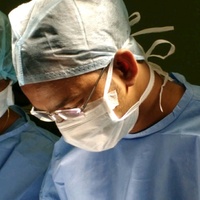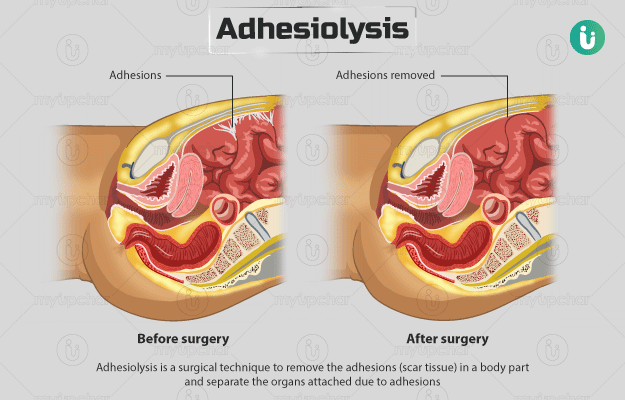Summary
Adhesiolysis is a surgery performed to remove the adhesions (scar tissue) that may have formed in the body after radiotherapy, surgery, trauma, infections, and inflammatory conditions. Adhesions can occur in any body part, including the joints, abdomen, pelvis, or the eyes and do not usually cause symptoms. However, a surgery is needed if the adhesions lead to symptoms such as pain, constipation or lose motions, obstruction of bowels, infertility, or the inability to move joints.
Before the surgery, your doctor will take your medical history and order multiple tests. Adhesiolysis is usually carried out by the laparoscopic method and takes nearly one to three hours. You will get discharged on the same day or the next day of surgery. A follow-up visit will be scheduled in about two weeks wherein the surgeon will check your healing progress.
- What is adhesiolysis?
- Why is adhesiolysis recommended?
- Who can and cannot get adhesiolysis?
- What preparations are needed before adhesiolysis?
- How is adhesiolysis done?
- How to care for yourself after adhesiolysis?
- What are the possible complications/risks of adhesiolysis?
- When to follow up with your doctor after adhesiolysis?
What is adhesiolysis?
Adhesiolysis is a surgical technique to remove the adhesions (scar tissue) in a body part and separate the organs attached due to adhesions. It is also known as lysis of adhesions.
Adhesions are scar tissues that form anywhere in the body, but are more commonly seen in the abdomen (stomach) and pelvis (area between the thighs and stomach). They cause the organs in these regions to stick to one another or other structures. Adhesions may also occur in the joints or eyes. However, the treatment for adhesions in the eyes is done by surgeries known as iridotomy and synechialysis.
Adhesions in the abdomen can be caused by different factors, including:
- Surgery: Adhesions are observed in patients after many open surgeries and a small number of laparoscopic (minimally invasive) surgeries.
- Radiation in the abdominal or pelvic region: Depending on the amount of radiation received and the type of cancer that was treated, the radiation may cause adhesions of varying severity.
- Infections and inflammatory conditions: Disorders like Crohn’s disease, endometriosis, abdominal tuberculosis, and pelvic inflammatory disease can cause adhesions in the abdomen and pelvic region.
Adhesions can also occur in the joints due to any surgery, arthritis, trauma, or due to overuse of a specific joint.
Adhesions do not cause symptoms in most people, but in a few people, symptoms are seen and the condition is known as adhesive disease. Surgery is performed to treat people who show symptoms.
Adhesiolysis is generally carried out by the laparoscopic method. In some rare cases, it may be performed by an open technique, but the chances of reoccurrence of adhesions after the open surgery are much higher.
Why is adhesiolysis recommended?
Adhesiolysis is most commonly performed to remove the adhesions in the abdomen due to adhesive disease.
The symptoms of adhesions in the abdomen and pelvic region include:
- Infertility
- Obstruction of bowels
- Pain
- Chronic bloating
- Cramping and gurgling sounds from the abdomen
- Constipation or loose motions
- Rectal bleeding and pain while defecating during periods
- Nausea
Adhesions in joints causes pain and difficulty during movement.
Who can and cannot get adhesiolysis?
Adhesiolysis can be more challenging in the following conditions:
- Removal of adhesions just two to three weeks after a surgery increases the risk of distortion of normal tissues and the formation of holes in the gastrointestinal tract.
- Adhesions formed after radiation therapy have blood vessels that make the procedure more complicated.
- Tissue that has had radiation therapy shows impaired healing and may not be able to tolerate the injuries from surgery.
- Adhesions that are formed along with tumours need to be removed entirely as the tumour may have spread in the surrounding tissues.
Laparoscopic adhesiolysis may be contraindicated in the following cases:
- Inflammation of the membrane covering the abdominal organs and wall
- Conditions such as lung or heart disease or bleeding disorders
- Swelling or enlargement of the abdomen
- Unstable blood pressure due to which blood does not flow to all the organs
What preparations are needed before adhesiolysis?
The following preparations are needed before adhesiolysis:
- Your doctor will take your medical history by asking questions about any prior surgery, radiation therapy, or inflammatory conditions as it may help in making the diagnosis of the condition.
- You will be asked to undergo a few tests like:
- Magnetic resonance imaging (MRI)
- Ultrasound
- Computed tomography (CT)
- Blood tests
- Urine tests
- Hysterosalpingography (an imaging technique used to view adhesions inside the fallopian tubes (tubes that help to transfer the eggs from the ovaries to the uterus) and uterus.
- Endoscopy (a small tube is passed into the body to see inside the uterus, pelvis, and abdomen)
- You will need to stop smoking and drinking before adhesiolysis to prevent complications after the surgery.
- You will be asked to fast from the midnight before the surgery.
- Inform your doctor about all the medications that you take. You may need to discontinue certain medicines before the surgery. This even includes non-prescription medicines, herbs and supplements.
- Your doctor may give you medicines to clear your bowels before the surgery.
- Arrange for a friend, family member, or responsible adult to take you back home after the surgery.
- The medical staff will ask you to sign a consent form if you agree to the procedure.
How is adhesiolysis done?
Once in the hospital, you will be asked to put on a hospital gown. You will wear special stockings or be given medicines to prevent clotting of blood in your legs. The medical staff will start an intravenous line (IV) in your arm or wrist to administer medicines and fluids during the surgery. You may be given antibiotics to prevent infections. In the operating room, you will lie on a medical table on your back.
The surgery will be performed under general anaesthesia; you will be asleep during the procedure. The medical staff will attach you to different devices to check your pulse, blood pressure, and oxygen level during the surgery. Once the effect of anaesthesia takes place, a catheter (tube) will be inserted in your bladder to remove urine.
The procedure for adhesiolysis in the abdominal and pelvic region by laparoscopy is as follows:
- The surgeon will make about two to four small cuts (incisions) on your abdomen.
- He/she will administer gas (carbon dioxide) to inflate your abdomen to look inside clearly and provide more workspace.
- Through one of the incisions, the surgeon will insert a thin, long tube with a camera (a laparoscope). This will help the surgeon to see your internal organs on a screen.
- Once the adhesions are located, the surgeon will insert other small instruments required for surgery through the other cuts on your abdomen.
- He/she will then cut out the adhesions to free the affected organs.
- After the surgery, the surgeon will remove all the instruments from the cuts, and close the incisions.
During open surgery, the surgeon will make a large cut on your abdomen to cut and free the adhesions.
The procedure for treating joint adhesions (arthroscopy) is the same as that used in the abdominal and pelvic region (minimally invasive surgery).
The surgery takes about one to three hours. Once the procedure is complete, the medical staff will shift you to a recovery room wherein you will be closely monitored until your vitals are stable. Once you wake up, you will be encouraged to move around. You will be given medication to control the pain after the surgery.
After a laparoscopic surgery, you will be discharged from the hospital on the same day, or you may need an overnight stay. However, if open surgery is performed, the hospital stay will last for a few days.
How to care for yourself after adhesiolysis?
You can care for yourself in the following ways after adhesiolysis:
- Your incisions will be covered by gauze which can be removed about 24 hours after the surgery. Make sure to keep the area covered with adhesive bandages for one or two days after that and wash the incisions with mild soap thereafter. The stitches need not be removed and fall off on their own in a few days.
- You will be prescribed pain medications, or you may take over-the-counter painkillers like paracetamol and ibuprofen as needed. Medicines to help with constipation may also be required.
- Eat fibre-rich foods and drink a lot of water to help with regular bowel movements.
- Move around and exercise as much as tolerated to improve your recovery. You will be able to increase your tolerance to exercise in the next few days.
- You may resume driving three days after the surgery.
- You may be allowed to swim after about a week.
- Avoid carrying heavy weights for at least two weeks after the surgery.
- If you feel comfortable, you may resume work in about two days.
- On the operated area, apply ice for about 20 minutes three to four times a day for a few days after the surgery. Use ice wrapped in a cloth to prevent frostbite (injury due to freezing of the skin and underlying tissues).
When to see the doctor?
Visit or call your doctor if you have any of the following symptoms:
- Nausea and vomiting
- Fever
- Pain that does not reduce with medicines
- Swelling, redness, excessive bleeding, or discharge from the surgical site
- Swelling in the abdomen
- Blood in stools or black stools
- Constipation or diarrhoea
- Increased joint swelling or pain in joints
- Failure to pass gas
When to follow up with your doctor after adhesiolysis?
Your follow-up will be scheduled two weeks, three months, six months, and a year after the procedure to check the progress of your healing.
Disclaimer: The above information is provided purely from an educational point of view and is in no way a substitute for medical advice by a qualified doctor.
Find General surgeon in cities
Surgery Cost In Your City
Doctors for Adhesiolysis

Dr. Piyush Jain
General Surgery
5 Years of Experience

Dr. Rajive Gupta
General Surgery
28 Years of Experience

Dr. Prity Kumari
General Surgery

Dr. Mangesh Yadav
General Surgery
5 Years of Experience
References
- Baylor Medicine [Internet]. Baylor College of Medicine. Texas. US; Adhesion Lysis
- Kulaylat MN, Dayton MT. Surgical complications. In: Townsend CM Jr, Beauchamp RD, Evers BM, Mattox KL, eds. Sabiston Textbook of Surgery. 20th ed. Philadelphia, PA: Elsevier; 2017:chap 12.
- National Institute of Diabetes and Digestive and Kidney Diseases [internet]: US Department of Health and Human Services; Abdominal Adhesions
- Kuemmerle JF. Inflammatory and anatomic diseases of the intestine, peritoneum, mesentery, and omentum. In: Goldman L, Schafer AI, eds. Goldman-Cecil Medicine. 26th ed. Philadelphia, PA: Elsevier; 2020:chap 133
- American Academy of Ophthalmology [Internet]. California. US; Synechiae
- Tabibian N, Swehli E, Boyd A, Umbreen A, Tabibian JH. Abdominal adhesions: a practical review of an often overlooked entity. Ann Med Surg (Lond). 2017 Mar;15:9–13. PMID: 28203370.
- Mount Sinai [Internet]. Icahn School of Medicine. New York. US; Adhesion
- UNC Department of Obstetrics and Gynecology [Internet]. UNC School of Medicine. North Carolina. US; Pelvic Adhesions (scar tissue)
- Beth Israel Lahey Health: Winchester Hospital [Internet]. Winchester. Maryland. US; Lysis of Adhesions
- Szomstein S, Lo Menzo E, Simpfendorfer C, Zundel N, Rosenthal RJ. Laparoscopic lysis of adhesions. World J Surg. 2006 Apr;30(4):535–540. PMID: 16555020.
- Kim Y-M, Joo YB. Prognostic factors of arthroscopic adhesiolysis for arthrofibrosis of the knee. Knee Surg Relat Res. 2013 Dec;25(4):202–206. PMID: 24368998.
- National Health Service [Internet]. UK; Having an operation (surgery)
- UK Healthcare [Internet]. University of Kentucky. Kentucky. US; Knee Arthroscopy Post-operative Instructions
- Cleveland Clinic [Internet]. Ohio. US; Post-operative Patient Instructions Laparoscopic Procedures















